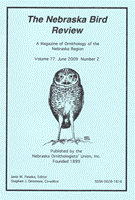Nebraska Ornithologists' Union

Nebraska Bird Review
Date of this Version
6-2022
Document Type
Article
Citation
The Nebraska Bird Review, Vol. 90 No. 2 (June 2022), pp. 71-75.
Abstract
On April 13 in Seward County, we noticed a dark bird flying relatively low over fields east of Seward near 224th and Bluff Rd. Initially, because of its size, dark coloration and pointed wingtips, we were unsure of its identification and followed the bird to get better looks and identify it. We were able to observe and photograph the bird perched (Figure 1). We also observed the bird hovering and diving to the ground multiple times in search of prey. After better looks, based on size, wing shape, hooked beak, claws, and behavior (repeated hovering over field), we concluded the bird was an American Kestrel (Falco sparverius). Joel and Camden returned later in the day and were able to relocate the bird. Camden got photos of the kestrel in flight showing additional details (Figure 2). We believe the observed bird was a female based on barring in the tail. As can be seen in the photos, the head and body patterns normally seen in American Kestrels are absent. Barring can be seen in both the underwings and the tail (Figures 1 and 2) while light-colored feathers are visible in the vent and belly. Both the cere and feet are yellow/orange normally seen in kestrels. Initially, we thought the bird was a melanistic American Kestrel. There is widespread misunderstanding about the causes of dark coloration in birds (Davis 2007; van Grouw 2017), so we shared the photos with people who had studied dark coloration in birds. Some believed the bird was melanistic and others believed it was soot-covered. We will discuss both below.
Included in
Ornithology Commons, Population Biology Commons, Poultry or Avian Science Commons, Zoology Commons


Comments
Published by the Nebraska Ornithologists’ Union, Inc.